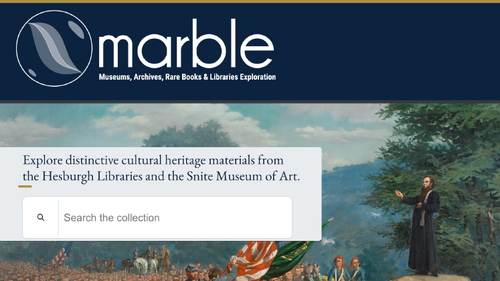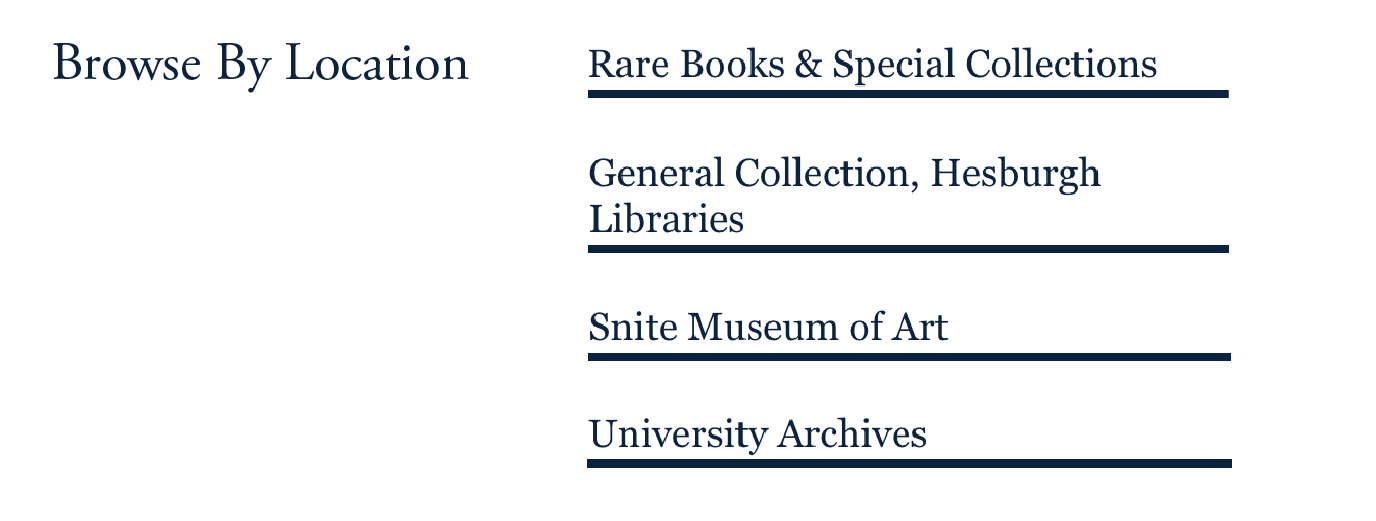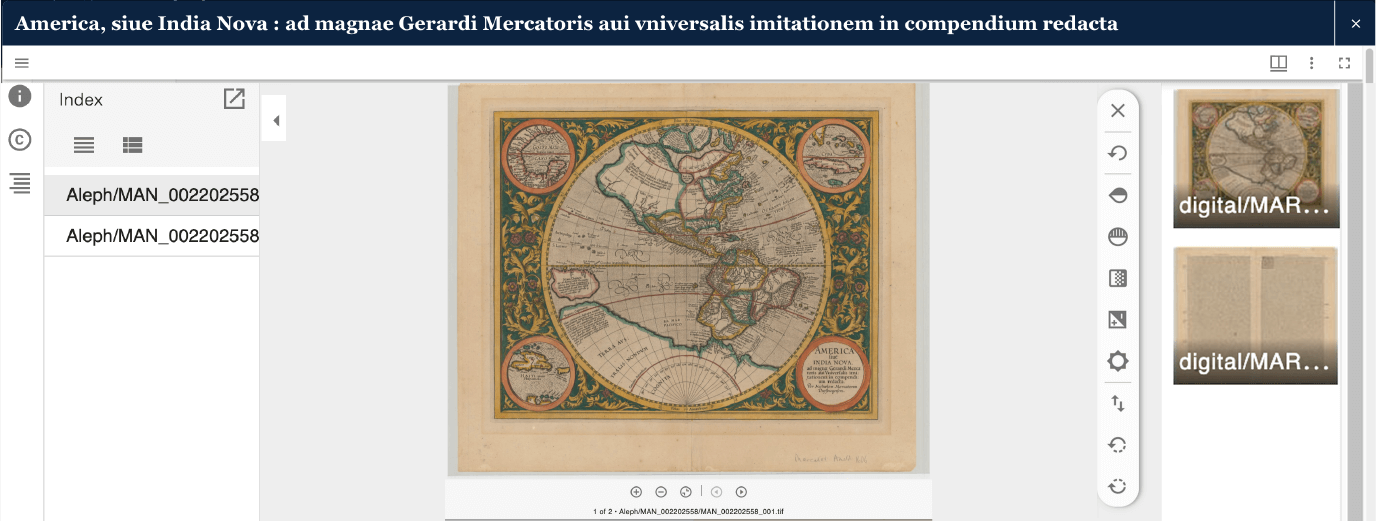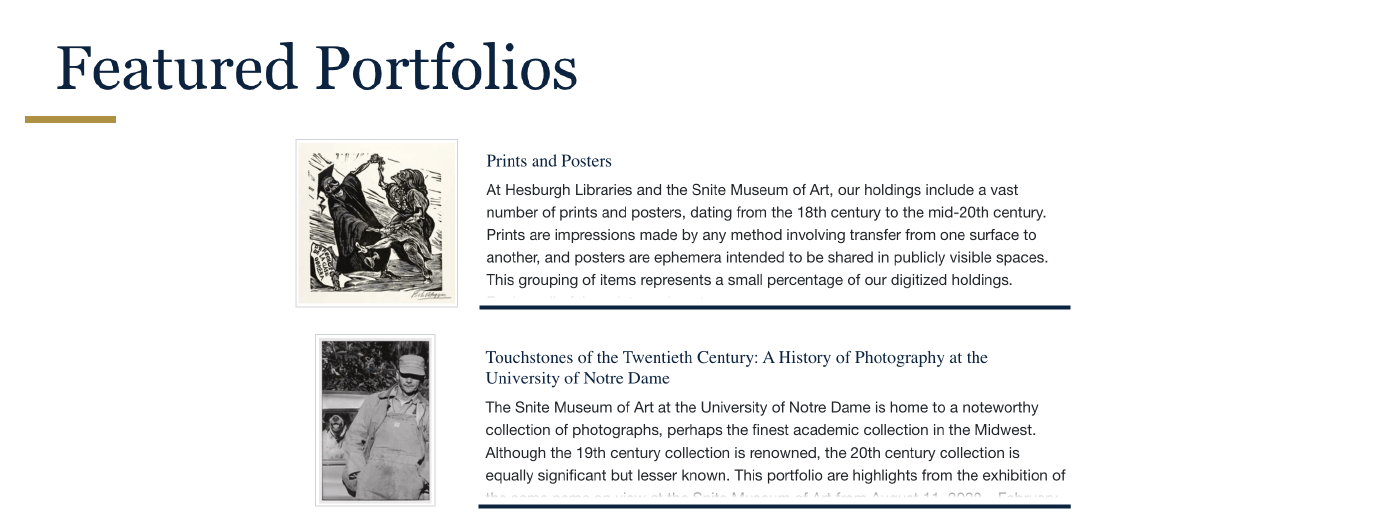
The Hesburgh Libraries and the Snite Museum of Art at the University of Notre Dame have launched Marble (Museums, Archives, Rare Books and Libraries Exploration) — an online teaching and research platform designed to make distinctive cultural heritage collections from across the University accessible through a single portal.
The development of Marble was made possible, in part, by a three-and-one-half-year grant from The Andrew W. Mellon Foundation to create an open-access, unified software solution that would enable universities to access museum and library holdings through a single online platform.
University libraries, archives and museums nationwide have been digitizing collections for well over a decade and have long sought collaborative solutions that would enable their respective holdings to be easily discovered online and used for teaching and research. However, there have been many obstacles preventing efficient and expansive research across collections, including disparate technical systems, discipline-specific practices and descriptive metadata norms.
A cross-disciplinary team developed Marble to address this universal challenge and to help transform teaching and research at Notre Dame and other institutions facing similar needs.
“Thanks to the hard work of so many in the Hesburgh Libraries and Snite Museum of Art and the generosity of the Mellon Foundation, Notre Dame is transforming the way scholars on campus and around the world further knowledge and advance research,” said Marie Lynn Miranda, the Charles and Jill Fischer Provost. “It’s a wonderful privilege for Notre Dame to play a role in preserving these important cultural heritage collections and in making those collections easier to access, explore, and investigate.”
The Snite Museum of Art, Rare Books & Special Collections and the University Archives have historically been independent gateways for faculty and students to engage with research collections, historical information and cultural objects. Users could access the physical collections at different locations and some item descriptions online, but few resources have been made available as digital surrogates, let alone through a single web platform.

In this unified discovery space, users now have open access to a selection of digitized cultural heritage collections that were once inaccessible. While these digitized materials are only a fraction of the University’s holdings, cross-institutional teams will collaborate to add new items regularly.
“The museum is grateful to be a part of this research partnership and the initial phase of the Marble project,” said Joseph Antenucci Becherer, director of the Snite Museum. “Offering the academy, and all users, access to our collections is deeply meaningful and useful in guiding the future of both research and teaching, not to mention pure enjoyment for even the more casual, curious user.”
“Marble offers key features that fundamentally transform the way digital collections can be used for teaching and research,” said Diane Parr Walker, the Edward H. Arnold University Librarian. “The museum and library collaboration and the grant outcomes will have a transformational impact on pedagogical access, scholarly engagement and research outcomes at Notre Dame.”
Faculty, students and the general public can browse Marble and download select digitized materials from the Snite Museum of Art, Rare Books & Special Collections and the University Archives in a single platform — including books, manuscripts, sculptures, paintings, photographs, ephemera and more. Each item displays one or more images with descriptive information and linked metadata to view related or similar items.

At the heart of Marble is an open-source image sharing standard called IIIF, or the International Image Interoperability Framework. IIIF is a set of universal specifications that provides a standardized way of storing and displaying images. One of the benefits of using IIIF images is that they can be viewed alongside other IIIF-compliant images from institutions around the world. IIIF viewing features include zoom, rotation, color manipulation, comparable viewing and options for cross-institutional research.

The Portfolio tool turns members of the Notre Dame community into curators, allowing each person to create customized lists and collections of content. Users browse, search and easily save items of interest into portfolios for future viewing. Portfolios are versatile — they can be shared for teaching, used for course assignments or annotated for individual research. They can remain private for personal use or be shared with students, campus peers or the public.
“Marble’s features are designed to facilitate primary resource discovery and streamline the research process. This platform allows for deep integration of the University’s cultural heritage holdings — regardless of where they reside,” said Mikala Narlock, digital collections strategy librarian. “We hope Marble will become an essential and indispensable platform for teaching and learning with digital collections at Notre Dame.”
The University of Notre Dame shares the Mellon Foundation’s commitment to advancing museum-library collaborations through freely available, scalable solutions.
The Marble software has been developed in the cloud, making it more scalable and less costly than software deployed on a local network infrastructure. It uses a harvest model to draw descriptive information from key source systems and features a shared administrative back-end to augment harvested data. This solution is possible due to a shared understanding of different descriptive terms.
In addition to a technical solution, the grant team facilitated critical social infrastructure conversations to optimize collection management and metadata workflows. The development roadmap will enable new features and continue to improve collaboration between libraries and museums.
The code for the Marble project was developed and will be maintained by the Hesburgh Libraries development team. The platform code is openly licensed under an Apache 2.0 license and available on GitHub. Project documentation, technical diagrams, collaborative processes and best practices are published on the Open Science Framework.
Online access to these selections of distinctive cultural heritage materials at Notre Dame is free and open to the public. Visit marble.nd.edu often to see new materials and featured portfolios published throughout the year.
Consultations and demonstrations for using Marble in teaching, research or general study are available by appointment. Contact Mikala Narlock, mnarlock@nd.edu, to arrange a time.
Contact: Gina Costa, Snite Museum of Art, 574-631-4720, Gcosta@nd.edu; Tara O’Leary, Hesburgh Libraries, 574-631-1856, toleary2@nd.edu